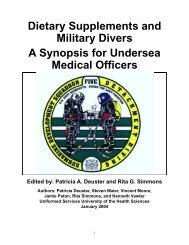Force Health Protection: Nutrition and Exercise Resource Manual
Force Health Protection: Nutrition and Exercise Resource Manual
Force Health Protection: Nutrition and Exercise Resource Manual
Create successful ePaper yourself
Turn your PDF publications into a flip-book with our unique Google optimized e-Paper software.
138 <strong>Force</strong> <strong>Health</strong> <strong>Protection</strong>:<br />
Chest<br />
Shoulders<br />
& Arms<br />
Back<br />
Legs<br />
Table C-1. Examples of Common Training Mistakes<br />
<strong>Exercise</strong> Common Mistakes Proper Form<br />
Bench Press<br />
Bench Press/<br />
Chest Fly<br />
Lateral Raises,<br />
Biceps Curls<br />
Lat Pulldowns/<br />
Seated Rows/<br />
T-bar Rows<br />
Squats/ Lunges/<br />
Leg Press<br />
Bouncing the bar off the ribs - uses momentum to lift<br />
the bar <strong>and</strong> can break ribs.<br />
Lifting the lower back <strong>and</strong> hips off bench when lifting<br />
the weight - weight too heavy, this motion increases<br />
stress on the spine.<br />
Arching the back when lifting the weights - uses<br />
momentum to lift the back <strong>and</strong> can cause back pain<br />
<strong>and</strong> injury.<br />
Rounding shoulders <strong>and</strong> bending forward at the<br />
waist when pulling the weight - uses body weight,<br />
not lat muscles to pull the bar; puts lots of stress on<br />
the spine.<br />
Squatting or bending knees beyond the tips of toes<br />
causes the heel to lift off deck <strong>and</strong> increases the<br />
stress on the knees as they move past the toes.<br />
General training mistakes that you should be aware of <strong>and</strong> avoid include:<br />
Lower bar to within 1 inch of the chest,<br />
pause, then lift.<br />
Decrease the weight to be lifted, keep<br />
lower back <strong>and</strong> hips on the bench.<br />
Decrease the weight to be lifted. Keep<br />
a natural curve in the back, bend<br />
knees, <strong>and</strong> push chest out. Lift <strong>and</strong><br />
lower the weight with control.<br />
Squeeze shoulder blades together,<br />
push chest out, back straight, <strong>and</strong> pull<br />
bar down to chest.<br />
Keep heels flat on deck <strong>and</strong> squat/<br />
lunge. Stop when knees are directly<br />
above toes.<br />
◆ Locking joints at the end of their range of motion. This places a lot of stress on the joint. You should<br />
extend the joint as far as possible without locking it during your exercises.<br />
◆ Moving your legs or “bouncing” during exercises. If you have to move or bounce body parts that are not<br />
directly involved in the exercise to lift a weight, then the weight is too heavy. Lower the weight <strong>and</strong><br />
check your form by focusing on how your body is moving; do not focus on lifting the weight.<br />
◆ Lifting <strong>and</strong> lowering weights rapidly. This can lead to injury. Slowly return the weight to the starting<br />
position, as this is the part of the workout that results in the greatest training effects!




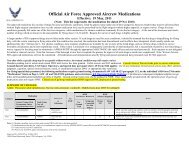
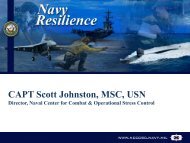
![Body Composition and Military [PDF] - Human Performance ...](https://img.yumpu.com/43269347/1/190x245/body-composition-and-military-pdf-human-performance-.jpg?quality=85)
![Tips for Grocery Shopping [PDF]](https://img.yumpu.com/37447379/1/190x245/tips-for-grocery-shopping-pdf.jpg?quality=85)
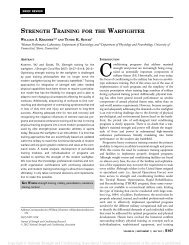
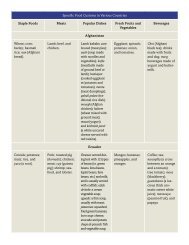
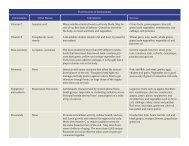
![Synthetic Drugs [PDF] - Human Performance Resource Center](https://img.yumpu.com/37447322/1/190x245/synthetic-drugs-pdf-human-performance-resource-center.jpg?quality=85)
